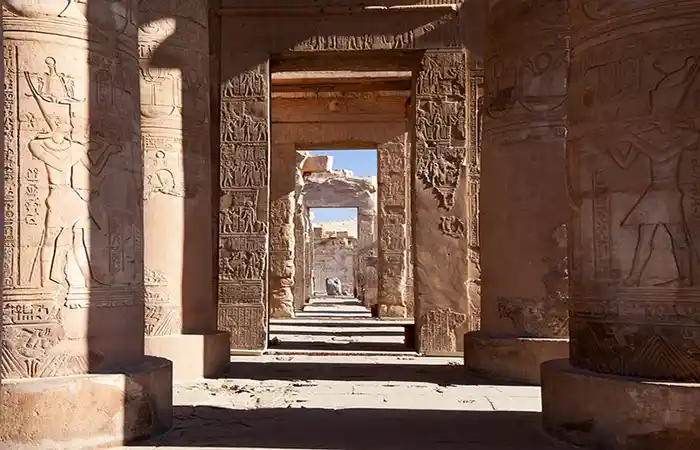Temple of Kom Ombo (Sobek temple)

Kom Ombo Temple (Sobek Temple) is a twin temple located in the city of Kom Ombo in Aswan Governorate, southern Egypt. The temple was built during the time of king Ptolemy VI on the honor of gods Sobek and Horus. It was added to the temple in the Roman era. Recently, restoration and renovation operations have taken place in the temple area.
The temple rises some 18 meters above the original plan of the city, and it was very clear for the travelers in the ancient time using the Nile River.
Kom Ombo was called Ombos and it is the first city below Aswan at which any remarkable remains and There are two temples at Kom Ombo, of the stone built out of stone brought from Jabal El Silsila
There are two temples at Ombos, constructed of the stone obtained from the neighboring quarries of Hagar Silsilah.
This temple was built during the time of Ptolemy VI Philometor, but its depictions and carvings was never completed until the Roman period, during the time of Emperor Tiberius. We also see in this temple the same characteristics that we find in other Ptolemaic Egyptian temples in terms of design, architecture and decoration. However, two local gods, Sobek and Horus with the head of a falcon were worshiped. These two gods differ in origin and character. They lived side by side for long centuries without mixing or acknowledging each other.
As for the heads of the columns in the temple, they are different, and this was common in the Ptolemaic era, and all of them were known before this era, especially those known as the heads of Hathor, the heads of palm trees, the heads of lotuses, and the heads of papyrus, which are truly Egyptian heads, and their Egyptian style has never been doubted.
The most common column heads in the Ptolemaic era were the composite column heads, in which some see without justification or reasonable cause a trace of the Corinthian column heads.
As for us, we believe that it is truly Egyptian, and the fruit of the artistic renaissance that flourished during the Sawi era – that is, in the seventh and sixth centuries BC – and aimed to revive ancient traditions, which produced many verses of Egyptian art.

The temple is divided into two parts, each of which is designated for the worship of one of these two gods.
The walls of this temple were decorated with pure Egyptian decoration, distinguished by its precision, good harmony, and the beauty of its balance between the characters of its scenes and the surrounding hieroglyphic inscriptions that complement these scenes.
From here, three antechambers, each with two entrances, lead to the Holy of holies of Sobek and Haroeris. The walls of the sanctuaries are now one or two courses high, allowing you to see the secret passage that enabled the priests to give the gods a ‘voice’ to answer the petitions of pilgrims.
The outer passage, which runs around the temple walls, is unusual leads to a scene of a collection of ‘surgical instruments. It seems more probable that these were some of the accoutrements used during the temple’s daily rituals, although the temple was certainly a place of healing or a sanatorium.
Much of the temple has been destroyed by the Nile, earthquakes, people reused the blocks in other projects. Sobek temple was partly destroyed by the early Christians as it was converted to a church.
The Nilometer located on the left side of the temple in an outer court next to God Haroris section on the temple and it was such a massive well used to measure the level of the Nile River during the flood season.
According to the level of water the government start to collect tax in the form of grains and serials as they know by the milometer if the year was prosperous or not for the farmers.
The path out of the complex leads to the new Crocodile Museum, a few of the three hundred crocodile mummies discovered in the vicinity are displayed in The Crocodile Museum.
The antiquities department announced the discovery of the head of the bust of the Roman Emperor Marcus Aurelius during work to protect the site from groundwater.
